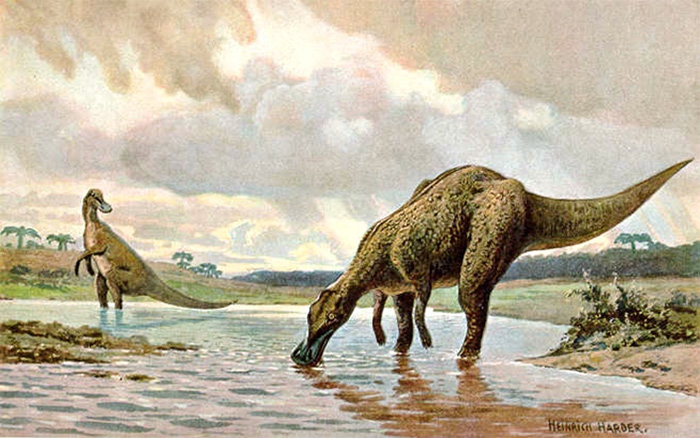
Recently, scientists discovered the fossil of a hadrosaur, a duckbilled dinosaur, which was bitten by a Tyrannosaurus.
A bite on a fossil is not that unusual, but this one helped settle an argument.
Over the past few decades, some paleontologists maintained that T. rex was a ferocious hunter.
Newer theories pointed to his useless forelimbs, small eyes, and huge olfactory chambers.
He wouldn’t have been able to grasp prey and may have had poor vision—but he would have been able to smell a rotting carcass from miles away. In other words, he was likely a scavenger.
But the hadrosaur tail vertebrae in this fossil were fused together around a T. rex tooth—the wound had healed.
This meant that the hadrosaur was alive when it happened, and lived on. Which strongly suggests that T. rex did in fact chase and catch it—almost.
This brought up another question: given his weaknesses, how did the tyrannosaur do it?
A different set of scientists analyzed the leg mechanics of T. rex for bone stress. Proponents of “T. rex the hunter” had pointed to his speed, previously estimated at over 30 miles per hour.
But this new research suggests that the foot bones, carrying his 7 tons of weight, would have shattered at that pace. The tyrannosaur’s top speed was probably just 12 miles per hour.
And maybe that’s why the duckbill got away—T. rex may have been an occasional hunter, but maybe not a very good one.
Background
Synopsis: A recent discovery of a fossil hadrosaur tail with a Tyrannosaurus rex tooth embedded in it provides proof positive that T. rex was a hunter—though not necessarily a fast one!
- One of the longest-running debates about the terrible tyrant is whether it was a deadly predator or a scavenger.
- In the past, evidence of T. rex bites, and even teeth, left in the bones of other dinosaurs has been reported, but with no clear-cut proof of whether these injuries resulted from active attacks or from scavenging.
- In 2013, researchers found definitive evidence of an attack from fossils in the Hell Creek Formation, a well-known fossil site in South Dakota.
- Two fused vertebrae from the tail of a hadrosaur had grown together as they healed around a fossil tooth 1.5 inches long.
- The shape of and serrations on the tooth confirmed that it came from the lower jaw of a T. rex.
- How did the chase go down?
- Skeletal studies show that the hadrosaur and tyrannosaur were fairly evenly matched, but the hadrosaur probably had better endurance; the T. rex could only “sprint” for short distances.
- The hadrosaur outlasted the T. rex, so it must not have been young or weak.
- The bite being on the tail supports the case for a chase; many predators attack the hindquarters of their victims.
- Recent research shows that T. rex’s bite could exert a pressure of more than 400,000 lbs per square inch—more than that of any other known animal—which enabled the crushing of larger bones for mineral salts and marrow, a nutritional advantage.
- How fast could T. rex really move?
- In the past, scientists estimated speeds of up to 40 mph based on the size of T. rex hind legs, but recent evidence has suggested that even a human could outrun an adult tyrannosaur.
- Using footprints found in a dinosaur trackway in Wyoming, scientists have been able to estimate the speed of local tyrannosaurs at 3–5 mph. Other studies based on footprints have suggested speeds up to 7 mph.
- A recent study used multiple biomechanical models to estimate the maximum speed of T. rex: 12 mph. Beyond that, its leg bones would have fractured on impact because of its sheer weight.
- Large mammals like elephants, who run with at least two feet on the ground at all times to support their weight, can only reach speeds up to 10 mph.

